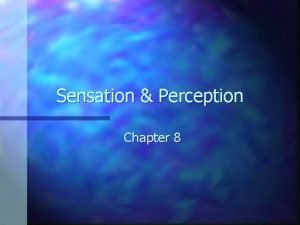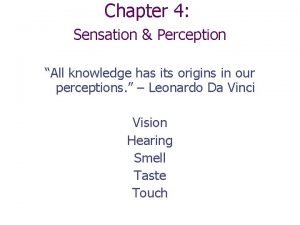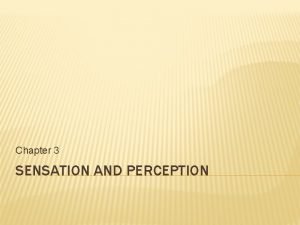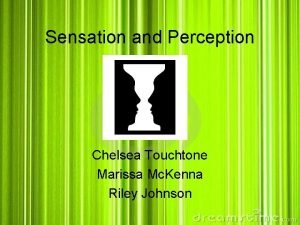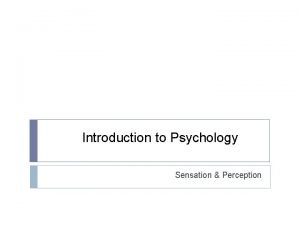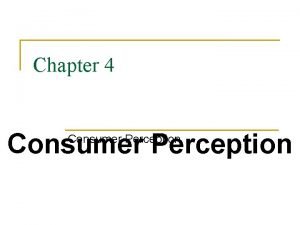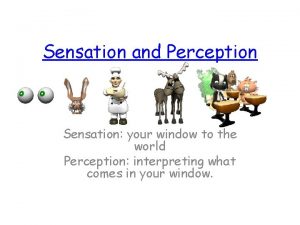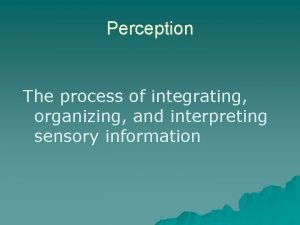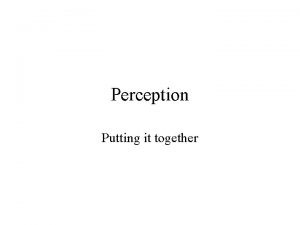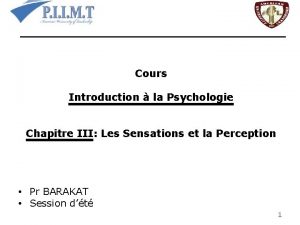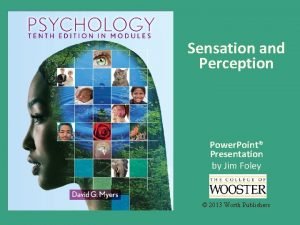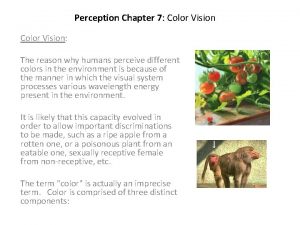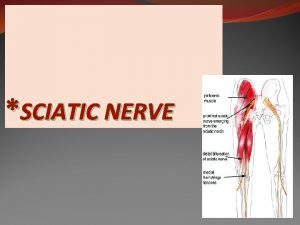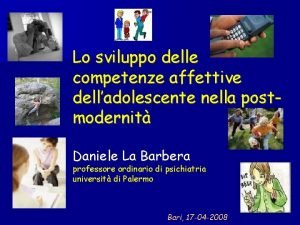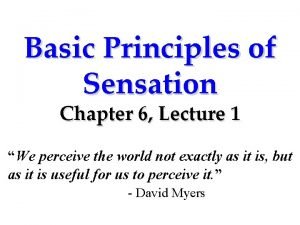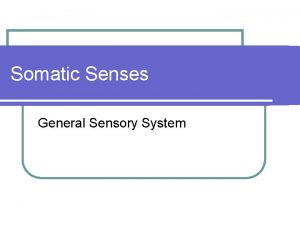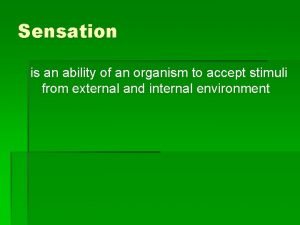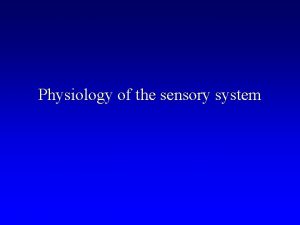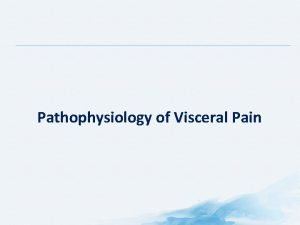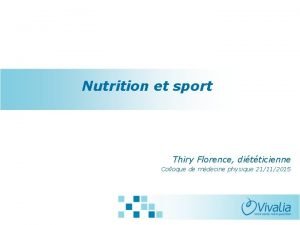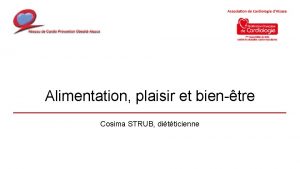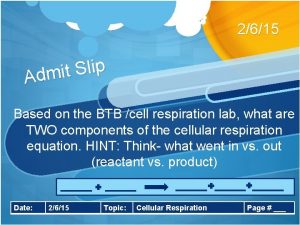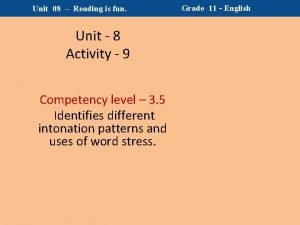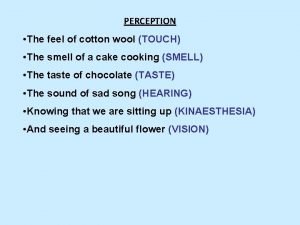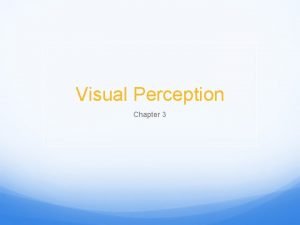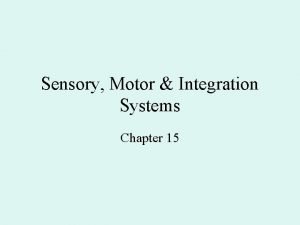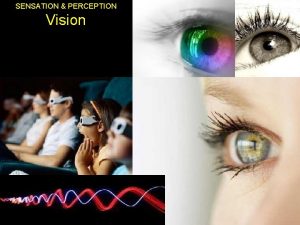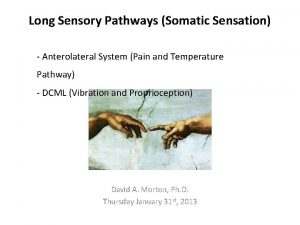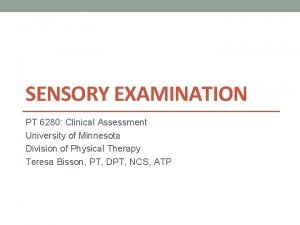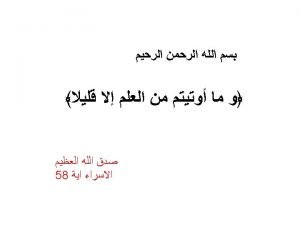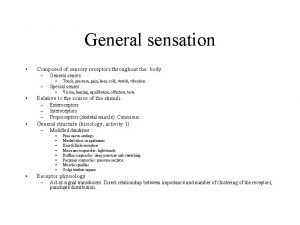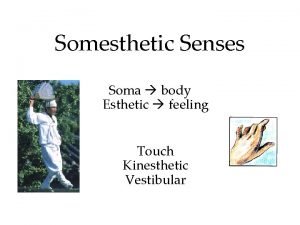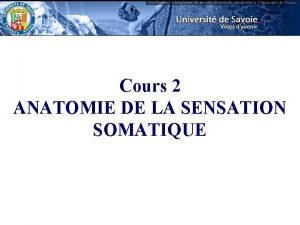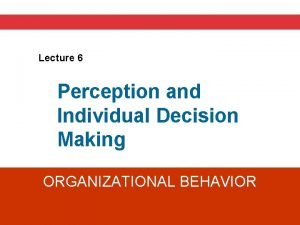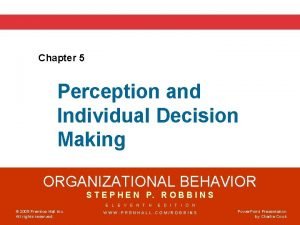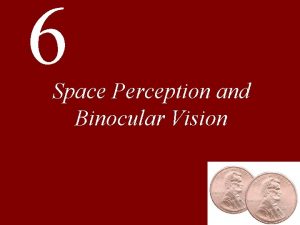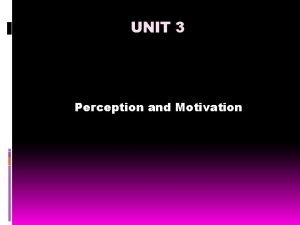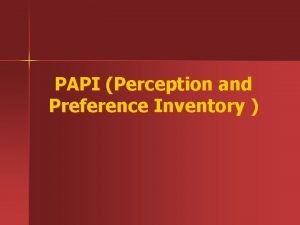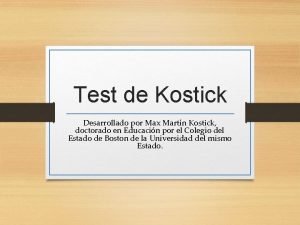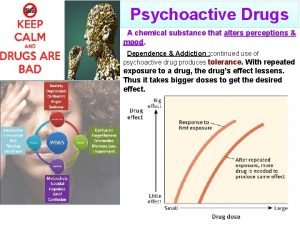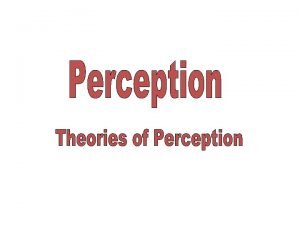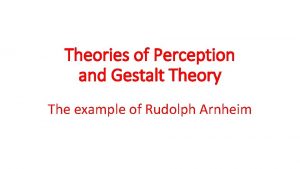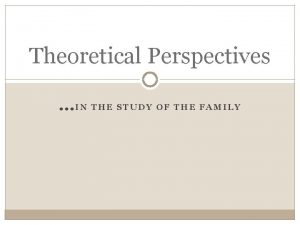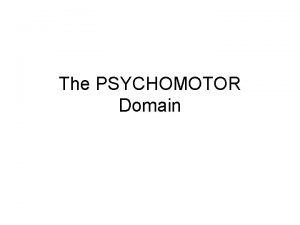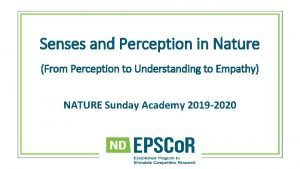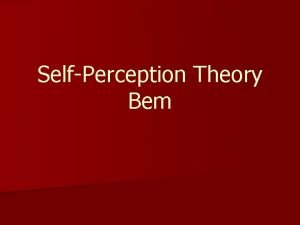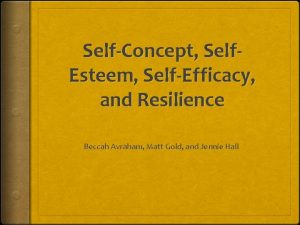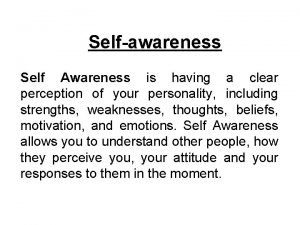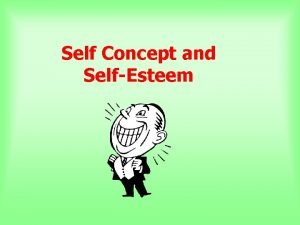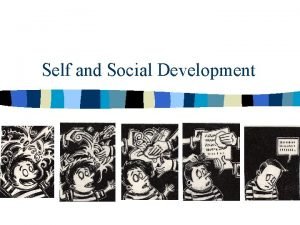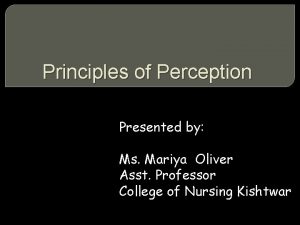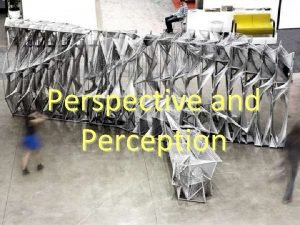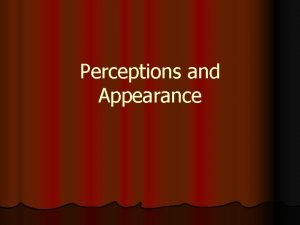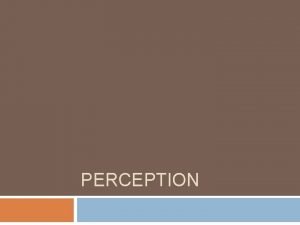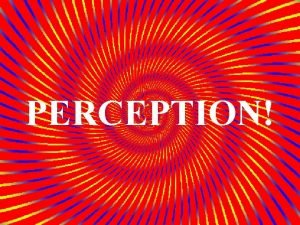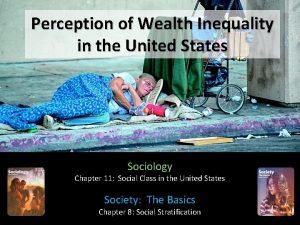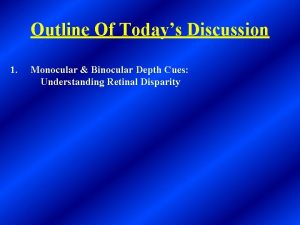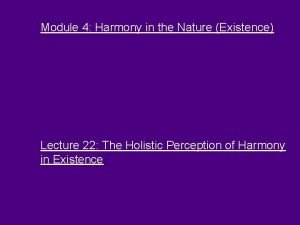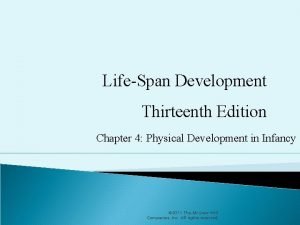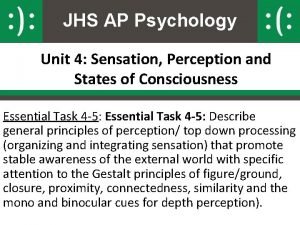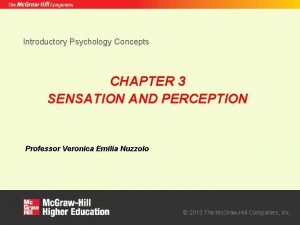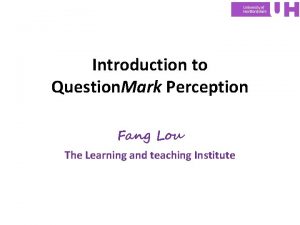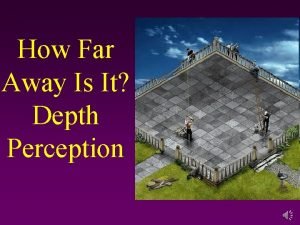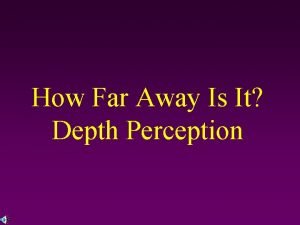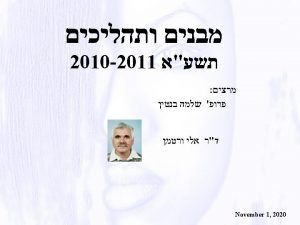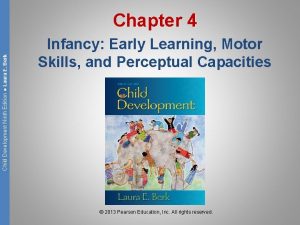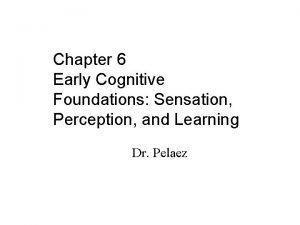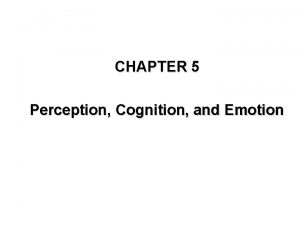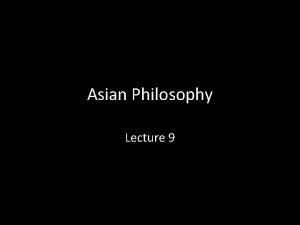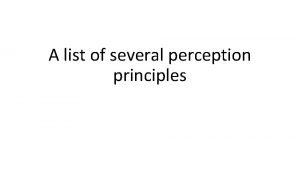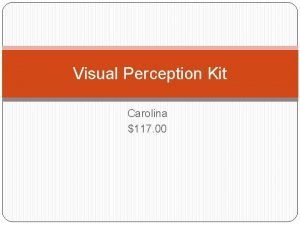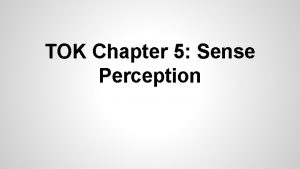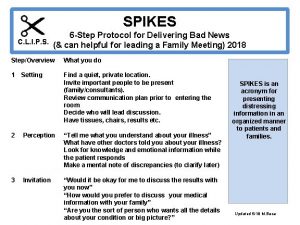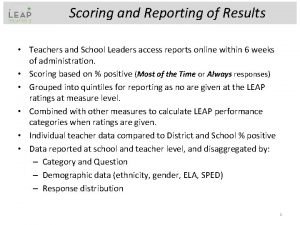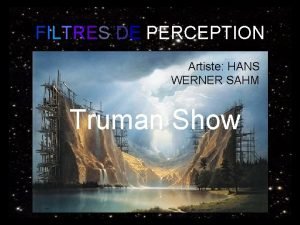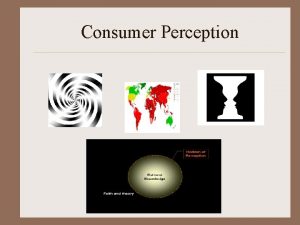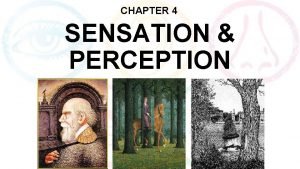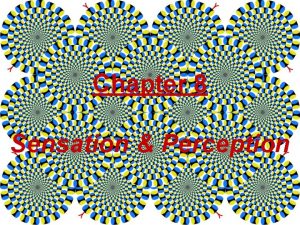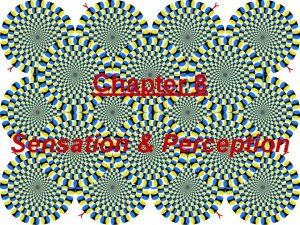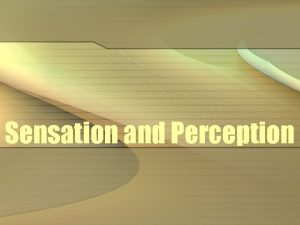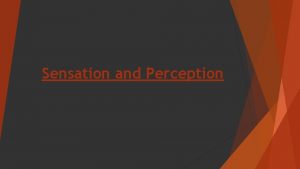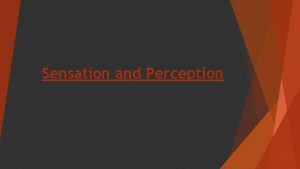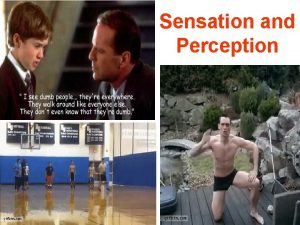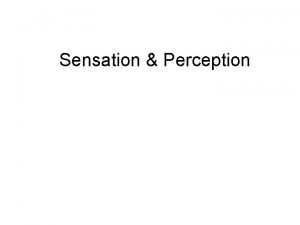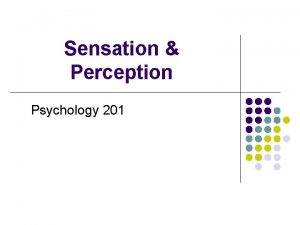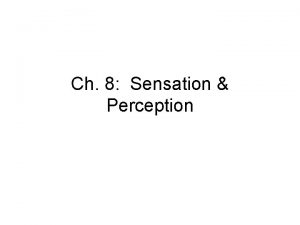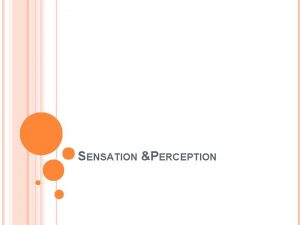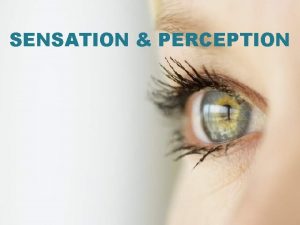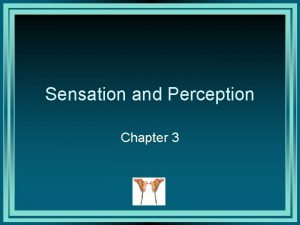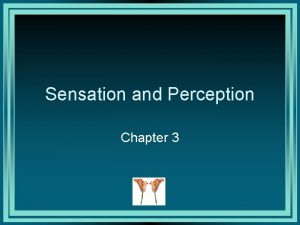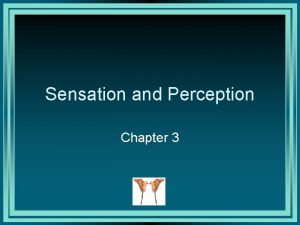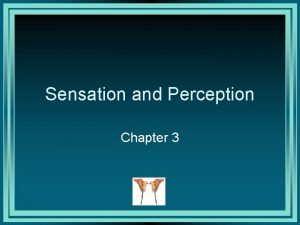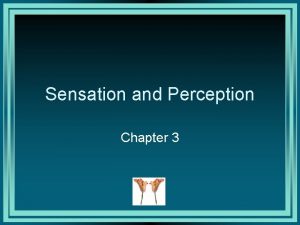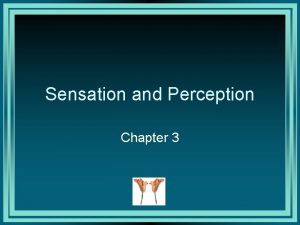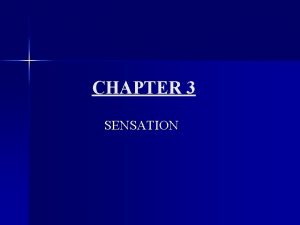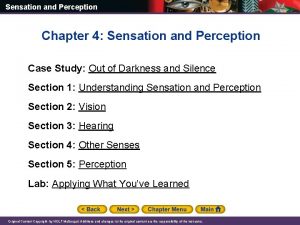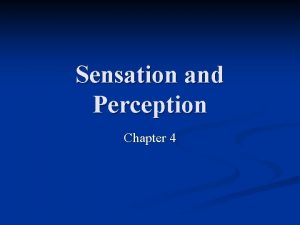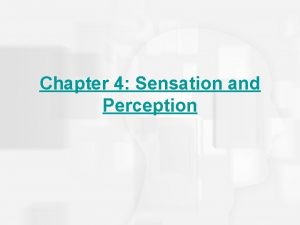Chapter 4 Sensation Perception Sensation and Perception Sensation






































































































- Slides: 102

Chapter 4 Sensation & Perception

Sensation and Perception Sensation – When neurons in a receptor create a pattern of nerve impulses Perception – A process that makes nerve patterns meaningful Copyright © Allyn and Bacon 2006

Is this Sensation or Perception? Aoccdrnig to a rscheearch at Cmabrigde Uinervtisy, it deosn't mttaer in waht oredr the ltteers in a wrod are, the olny iprmoetnt tihng is taht the frist and lsat ltteer be at the rghit pclae. The rset can be a toatl mses and you can sitll raed it wouthit porbelm. Tihs is bcuseae the huamn mnid deos not raed ervey lteter by istlef, but the wrod as a wlohe. Copyright © Allyn and Bacon 2006

How Does Stimulation Become Sensation? The brain senses the world indirectly because the sense organs convert stimulation into neural impulses, which the brain must interpret Copyright © Allyn and Bacon 2006

Transduction Receptors – Specialized neurons activated by stimulation that perform transduction Transduction – Transformation of stimulus information into nerve impulses Copyright © Allyn and Bacon 2006

Extra Sensory Perception Does it exist? Let’s try an experiment Copyright © Allyn and Bacon 2006

Sensory Adaptation Sensory adaptation – Loss of responsiveness in receptor cells after stimulation has remained unchanged for a while Coffee demonstration Stare at the black dot on the next page Copyright © Allyn and Bacon 2006


How “sens”itive are you? Let’s take a self-quiz on handout 4 -3 Highly sensitive does not necessarily mean introverted. High scores often correlate to creativity, but also to the tendency to get easily overwhelmed and to need to be alone. HSPs are often conscientious, intuitive and imaginative, but underperform when being evaluated. HSPs tend to socialize less with others, often preferring to process experiences quietly by themselves. The ability to unconsciously process environmental subtleties can contribute to an HSP seeming to possess a "sixth sense". Copyright © Allyn and Bacon 2006

Habituation a decrease in a behavior due to repeated presentation of a stimulus -occurs in the brain (it is learned), not the body Is your ears becoming accustomed to loud music at a concert adaptation or habituation? How about becoming able to work in a noisy environment? Copyright © Allyn and Bacon 2006

Thresholds Absolute threshold – Amount of stimulation necessary for a stimulus to be detected vision: a candle at 30 miles sound: tick of a mechanical watch at 20 feet [let’s try it with my clock!] (echolocation: part 2) taste: 1 tsp of sugar in 2 gallons of water smell: one drop of perfume in a 3 BR apt. touch: the wing of a bee falling on your cheek from a distance of 1 cm. Copyright © Allyn and Bacon 2006

Copyright © Allyn and Bacon 2006

Copyright © Allyn and Bacon 2006

Copyright © Allyn and Bacon 2006

Copyright © Allyn and Bacon 2006

Copyright © Allyn and Bacon 2006

Copyright © Allyn and Bacon 2006

Copyright © Allyn and Bacon 2006

Copyright © Allyn and Bacon 2006

Copyright © Allyn and Bacon 2006

Copyright © Allyn and Bacon 2006

Copyright © Allyn and Bacon 2006

Did you notice anything? Copyright © Allyn and Bacon 2006

Just noticeable difference Copyright © Allyn and Bacon 2006

Thresholds Difference threshold – Smallest amount a stimulus can be changed and the difference can be detected half the time (AKA just noticeable difference – JND) Copyright © Allyn and Bacon 2006

Thresholds Weber’s law – The JND between two stimuli is proportional to the magnitude of the stimuli (envelope experiment) Fechner’s law – increases in physical strength of a stimulus produce progressively smaller increases in perceived magnitude (turning up the car stereo) Copyright © Allyn and Bacon 2006

Signal Detection Theory --a way to quantify the ability to distinguish between signal and noise --emphasizes judgment and decision-making processes --experience, expectations, physiological state (e. g. fatigue) and other factors can affect the threshold applied. Stimulus event Neural activity Comparison (applying threshold) Action (or no action) Copyright © Allyn and Bacon 2006

Signal Detection Theory Response Absent Response Present Stimulus Present Miss Hit Stimulus Absent Correct Rejection False Alarm Let’s think of a real-world situation for each of the four scenarios: 1. Miss 2. Hit 3. Correct rejection 4. False alarm Copyright © Allyn and Bacon 2006

How Are the Senses Alike? How Are They Different? Each sense operates in similar ways, but each extracts different information and sends it to its own specialized processing region in the brain Copyright © Allyn and Bacon 2006

However… The visual system often overrides our other senses. For instance, the Mc. Gurk Effect Vision can also override our sense of touch -Let’s conduct an experiment with weight Copyright © Allyn and Bacon 2006

How the Visual System Creates Color Visible spectrum – Tiny part of the electromagnetic spectrum (which includes radio waves, microwaves and X-rays) to which our eyes are sensitive Copyright © Allyn and Bacon 2006

Electromagnetic Energy Spectrum Copyright © Allyn and Bacon 2006

Electromagnetic Energy Spectrum Copyright © Allyn and Bacon 2006

The Physical Property of Waves Copyright © Allyn and Bacon 2006

The Physical Property of Waves Copyright © Allyn and Bacon 2006

The Physical Property of Waves Copyright © Allyn and Bacon 2006

The Physical Property of Waves Copyright © Allyn and Bacon 2006

The Physical Property of Waves Copyright © Allyn and Bacon 2006

How the Visual System Creates Color constancy— constancy perceived color of objects remains relatively constant under varying illumination conditions Color blindness – prevents one from discriminating certain colors (most common is red/green; complete CB is very rare) Copyright © Allyn and Bacon 2006

Color Vision Young-Helmholtz trichromatic (three color) theory Three types of cones in the eye Red – Green - Blue Copyright © Allyn and Bacon 2006

Color Vision Opponent-process theory: Bipolar and ganglion cells receive signals from the three types of cones and process them at a more complex level. Three sets of colors involved in processing colors Red-green Blue-yellow Black-white Afterimage Copyright © Allyn and Bacon 2006

Copyright © Allyn and Bacon 2006

Copyright © Allyn and Bacon 2006

Afterimages – Sensations that linger after the stimulus is removed—prove opponent-process theory Copyright © Allyn and Bacon 2006

A person with color vision will see… Red, orange, yellow, green, blue and violet (ROYGBi. V) Copyright © Allyn and Bacon 2006

What people with different types of color blindness see tritanopia protanopia deuteranopia Copyright © Allyn and Bacon 2006

Brain Break! Saccadic Eye Movements Look at figures from handout 4. 6 Copyright © Allyn and Bacon 2006

The Structure of the Eye Take a few minutes and draw this on your notes Copyright © Allyn and Bacon 2006

The Structure of the Eye Cornea = outer covering of the eye. Copyright © Allyn and Bacon 2006

The Structure of the Eye Pupil = the adjustable opening in the center of the eye through which light enters. Copyright © Allyn and Bacon 2006

The Structure of the Eye Iris = a ring of muscle tissue that forms the colored portion of the eye around the pupil and controls the size of the pupil opening. • The iris dilates/constricts in response to changing light intensity Copyright © Allyn and Bacon 2006

The Structure of the Eye Lens = the transparent structure behind the pupil that changes shape to help focus images on the retina. Copyright © Allyn and Bacon 2006

The Structure of the Eye Retina = the light-sensitive inner surface of the eye, containing the receptor rods and cones plus layers of neurons that begin processing visual information. Copyright © Allyn and Bacon 2006

The Eye The Retina Rods and Cones Rods Copyright © Allyn and Bacon 2006

Rods versus Cones Let’s try the marker experiment Copyright © Allyn and Bacon 2006

Transduction of Light in the Retina Copyright © Allyn and Bacon 2006

The Structure of the Eye Blind Spot = the point at which the optic nerve leaves the eye, creating a “blind” spot because no receptor cells are located there. Copyright © Allyn and Bacon 2006

The Structure of the Eye Fovea = the central focal point in the retina, around which the eye’s cones cluster. Copyright © Allyn and Bacon 2006

The Structure of the Eye Optic Nerve = the nerve that carries neural impulses from the eye to the brain. Copyright © Allyn and Bacon 2006

Visual Information Processing Visual Cortex Copyright © Allyn and Bacon 2006

Pathways from the eyes to the visual cortex Copyright © Allyn and Bacon 2006

Pathways from the eyes to the visual cortex Copyright © Allyn and Bacon 2006

Pathways from the eyes to the visual cortex Copyright © Allyn and Bacon 2006

Pathways from the eyes to the visual cortex Copyright © Allyn and Bacon 2006

Monocular cues for depth perception Relative size: I’m crushing your head Light and shadow: bouncing basketball in Brain Games Interposition: nearer objects hide further ones Relative motion: motion Looking out the window on the highway Atmospheric perspective: Grand Canyon BRAIN BREAK! Binocular cues Binocular convergence: put a finger 1 inch from your face Retinal disparity: close your left eye and put your thumb over the clock. Now close your right eye and open your left eye. What do you see? Copyright © Allyn and Bacon 2006

Hearing: an overview The Physics of Sound Frequency (wavelength)– Number of cycles completed by a wave in a given amount of time; determines pitch Low Frequency High Frequency Copyright © Allyn and Bacon 2006

Hearing: If a Tree Falls in the Forest. . . The Physics of Sound Amplitude (intensity) – Physical strength of a wave; determines loudness High Amplitude Low Amplitude Copyright © Allyn and Bacon 2006

The Psychology of Pitch, Loudness, and Timbre – Quality of a sound wave that derives from the wave’s complexity (aka waveform) -if you and I sang the same note at the same volume, you could tell the difference between our voices because of the timbre. Copyright © Allyn and Bacon 2006

How Sound Waves Become Auditory Sensations Tympanic membrane – The eardrum Copyright © Allyn and Bacon 2006

How Sound Waves Become Auditory Sensations Cochlea – Where sound waves are transduced Copyright © Allyn and Bacon 2006

How Sound Waves Become Auditory Sensations Cochlea Basilar membrane – Thin strip of tissue inside the cochlea sensitive to vibrations Copyright © Allyn and Bacon 2006

Deafness Conduction deafness – resulting from damage to the middle or inner ear Nerve deafness – inability to transmit impulses from the cochlea to the brain, usually involving the auditory nerve or auditory processing centers Copyright © Allyn and Bacon 2006

Position and Movement Vestibular sense – Sense of body orientation in relation to gravity; comes from semicircular canals -JFK Jr. ; Simulator Kinesthetic sense – Sense of body position and movement of body parts relative to each other -put your hands behind your back; put the left in front of your right; now vice versa Copyright © Allyn and Bacon 2006

Smell The only sense not routed through the thalamus Olfaction –Sense of smell Olfactory bulbs – Brain sites of olfactory processing Pheromones – Chemical signals released to communicate with other members of the species Copyright © Allyn and Bacon 2006

Smell Copyright © Allyn and Bacon 2006

Taste Gustation – The sense of taste Taste buds – Receptors for taste (primarily on the upper side of the tongue) The five tastes: sweet, sour, bitter, salty and umami The tongue’s “taste map” is largely a myth Copyright © Allyn and Bacon 2006

The Skin Senses Pain: Gate-control theory: theory that fast (thick) nerve fibers can block the messages from the slow (thin) fibers The reason we rub or shake the part of our body that hurts. Copyright © Allyn and Bacon 2006

What is the Relationship Between Perception and Sensation? Perception brings meaning to sensation, so perception produces an interpretation of the external world, not a perfect representation of it. Copyright © Allyn and Bacon 2006

The Machinery of Perceptual Processing Feature detectors – Cells in the cortex that specialize in extracting specific features of a stimulus Binding problem – An unsolved mystery: how does the brain combine sensations into a single percept? e. g. prosopagnosia: inability to recognize faces Most people see faces everywhere Copyright © Allyn and Bacon 2006

Bottom-Up and Top-Down Processing Bottom-up processing – emphasizes characteristics of the stimulus, rather than expectations -sounding out words Top-down processing – Emphasizes perceiver's expectations, memories, and other cognitive factors -reading the scrambled words on the third slide of this Power. Point Copyright © Allyn and Bacon 2006

IUMRING TQ GQNGI USIQNS Copyright © Allyn and Bacon 2006

IUMRING TQ GQNGI USIQNS Copyright © Allyn and Bacon 2006

Perceptual Constancies Perceptual constancy – Ames room Ability to recognize the same object under different conditions, such as changes in illumination, distance, or location The amazing color changing card trick; part 2 Change blindness – a change in visual stimuli goes unnoticed by the observer. Great website here. Use your attention to solve the mystery Similar to choice blindness Copyright © Allyn and Bacon 2006

Perception Constancies help us keep the world sensible, but are also responsible for many visual illusions. size, shape, color constancies Copyright © Allyn and Bacon 2006

Perceptual Illusions: Necker Cube Do you see or ? Copyright © Allyn and Bacon 2006

Selective Attention the focusing of conscious awareness on one stimulus. Cocktail party effect: ability to focus attention on one audio stimulus (e. g. conversation) among a cacophony of conversations and noise Copyright © Allyn and Bacon 2006

Pay attention Count the number of times the people in white pass the basketball to other players. How do others do at this? this Inattentional blindness: failing to see visible objects when our attention is directed elsewhere. Copyright © Allyn and Bacon 2006

Like the Necker Cube, our brains try very hard to make sense out of stimuli that doesn’t give us enough information to make sense of it. Copyright © Allyn and Bacon 2006

Theoretical Explanations for Perception Let’s test your listening skills! Learning-based inference – View that perception is primarily shaped by learning, rather than innate factors Pg. 57 in Makosky volume 2 Perceptual set – Readiness to detect a particular stimulus in a given context; expectations determine perception Copyright © Allyn and Bacon 2006

Half of the class unscramble these letters silently LULB CALEM NUKKS SUEMO BAZER EAP Copyright © Allyn and Bacon 2006

Now the other half unscramble these letter silently NORC NOONI MATOOT PREPPE TEBE EAP Copyright © Allyn and Bacon 2006

How did you unscramble this? EAP? It was based on your perceptual set! Copyright © Allyn and Bacon 2006

Copyright © Allyn and Bacon 2006

The Gestalt Approach Gestalt psychology – View that our perception is designed to see wholes before we see parts Figure – Part of a pattern that commands attention Ground – Part of a pattern that does not command attention; the background Copyright © Allyn and Bacon 2006

Figure/Ground Copyright © Allyn and Bacon 2006

The Gestalt Laws of Perceptual Grouping Prägnanz Proximity Continuity Common fate Similarity Closure Copyright © Allyn and Bacon 2006

Law of Prägnanz (a. k. a. Law of Simplicity) A BIRD IN THE HAND The simplest organization, the one that requires the least cognitive effort, will emerge as the percept. Copyright © Allyn and Bacon 2006

proximity Are these columns or rows? Copyright © Allyn and Bacon 2006

similarity Copyright © Allyn and Bacon 2006

Continuity Are these two crossed lines or four lines meeting at the center? Or two 90 degree angles? Copyright © Allyn and Bacon 2006

The Gestalt Approach Subjective contours – Nonexistent boundaries that are perceived Closure – Tendency to fill in gaps in figures and to see incomplete figures as complete Copyright © Allyn and Bacon 2006

End of Chapter 4 As you study, pay special attention to -signal detection theory -rods/cones -perceptual set -frequency and amplitude -retinal disparity -absolute threshold -Gestalt principles Let’s try the Mc. Collough Effect Copyright © Allyn and Bacon 2007
 Chapter 5 sensation and perception
Chapter 5 sensation and perception Chapter 3 sensation and perception
Chapter 3 sensation and perception Chapter 6 sensation and perception
Chapter 6 sensation and perception Chapter 4 sensation and perception test
Chapter 4 sensation and perception test Chapter 6 sensation and perception
Chapter 6 sensation and perception Sensation perception
Sensation perception Chapter 4 sensation and perception
Chapter 4 sensation and perception Chapter 3 sensation and perception
Chapter 3 sensation and perception Principles of visual perception
Principles of visual perception Perceptual set ap psych
Perceptual set ap psych What is sensation and perception
What is sensation and perception Sensation and perception crossword review
Sensation and perception crossword review Sensation and perception
Sensation and perception Sensation and perception in marketing
Sensation and perception in marketing Sensation and perception
Sensation and perception Sensation and perception
Sensation and perception Sensation and perception uu
Sensation and perception uu Perception vs sensation
Perception vs sensation Sensation et perception en psychologie
Sensation et perception en psychologie Perception vs sensation
Perception vs sensation Face recognition
Face recognition Color vision
Color vision Horizontal e vertical
Horizontal e vertical Sensation seeking
Sensation seeking Branch of sciatic nerve
Branch of sciatic nerve Sensation seeking significato
Sensation seeking significato Principles of sensation
Principles of sensation Thermoreceptors
Thermoreceptors Types of sensation
Types of sensation Cortical sensation
Cortical sensation Does muscle spasms cause burning sensation
Does muscle spasms cause burning sensation Ditticienne base sur coute sensation
Ditticienne base sur coute sensation Ditticienne base sur coute sensation
Ditticienne base sur coute sensation What causes the burning sensation in your muscles
What causes the burning sensation in your muscles Vocabulary activity 8-1 sensation answer key
Vocabulary activity 8-1 sensation answer key Cotton wool sensation
Cotton wool sensation Sensation
Sensation Sensation
Sensation Sensation
Sensation Dcml sensation
Dcml sensation What is the difference between sensing and intuition
What is the difference between sensing and intuition Cortical sensation
Cortical sensation Dr abdel
Dr abdel Nociceptive pain
Nociceptive pain General sensation
General sensation Body esthetic
Body esthetic Sensation somatique
Sensation somatique Sejarah tes papi kostick
Sejarah tes papi kostick Perception and individual decision making
Perception and individual decision making Eudemonistic model
Eudemonistic model What they see
What they see Subjective perception of vitality and feeling well
Subjective perception of vitality and feeling well Familiar size
Familiar size Motivation and perception
Motivation and perception Perception and preference inventory
Perception and preference inventory Test de kostick
Test de kostick A chemical substance that alters perceptions and mood
A chemical substance that alters perceptions and mood Gregory top down theory of perception
Gregory top down theory of perception Gestalt in film
Gestalt in film Perspective vs perception
Perspective vs perception Perception in psychomotor domain
Perception in psychomotor domain Objective perception
Objective perception Nature of perception
Nature of perception Bem’s self-perception theory
Bem’s self-perception theory Self concept vs self esteem
Self concept vs self esteem It is having a clear perception of your personality
It is having a clear perception of your personality Self image vs self perception
Self image vs self perception Self concept vs self esteem
Self concept vs self esteem Principle of adaptability in perception
Principle of adaptability in perception Perspective quotes
Perspective quotes Perception checks
Perception checks What does the word perception mean
What does the word perception mean What does the l mean
What does the l mean Selective perception
Selective perception Questions on perception
Questions on perception Perception of wealth
Perception of wealth What affects perception
What affects perception Crossed disparity
Crossed disparity Understanding harmony in the nature and existence
Understanding harmony in the nature and existence Rooting reflex
Rooting reflex Depth perception ap psychology
Depth perception ap psychology Perception meaning in psychology
Perception meaning in psychology Question mark perception
Question mark perception Relative motion perception
Relative motion perception Cues of depth perception
Cues of depth perception Categorical perception
Categorical perception Categorical perception psychology
Categorical perception psychology Intermodal perception
Intermodal perception Intermodal perception
Intermodal perception Intermodal perception
Intermodal perception Cognition vs perception
Cognition vs perception Vaisheshika philosophy
Vaisheshika philosophy Relative size monocular cue
Relative size monocular cue Carolina visual perception kit
Carolina visual perception kit Sense perception tok
Sense perception tok Six step protocol for delivering bad news
Six step protocol for delivering bad news Student perception survey dps
Student perception survey dps Levels of perception
Levels of perception Perception checking process
Perception checking process Prospect mill elementary school
Prospect mill elementary school Adrika mon filtre d'amour
Adrika mon filtre d'amour Process of perception
Process of perception Consumer perception process
Consumer perception process





